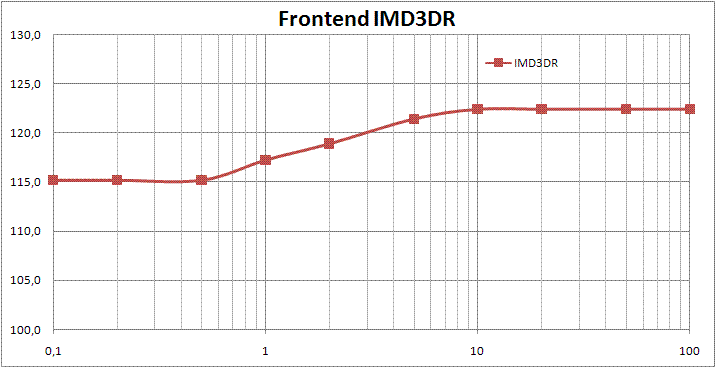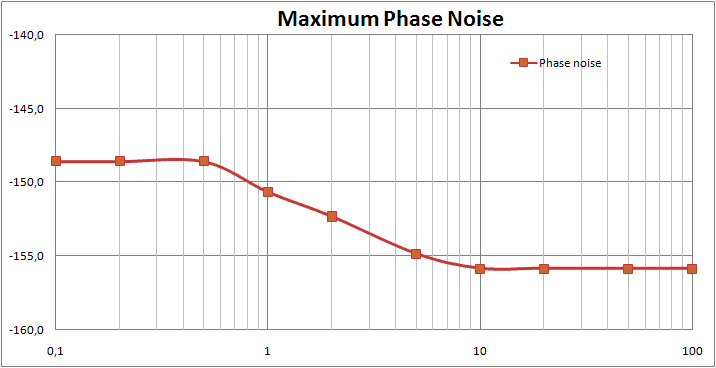Introduction
With the down-conversion frontend now realized, consisting of antenna BPF's, H-Mode mixer and SSB + CW roofing filters, the next most critical and challenging subsystem is arguably the local oscillator (LO) that drives the H-Mode mixer. All the attention of the frontend design so far went into maximizing third order intercept (IP3) at the best possible sensitivity (MDS) needed for an HF receiver. This is also called "third order intercept dynamic range", in short IMD3DR. An IMD3DR in SSB bandwidth slightly in excess of 120dB on the lower HF bands has been achieved with this frontend.
This result puts the bar pretty high when designing the LO, especially with regard to phase noise and spur levels. In other words, unless the sideband noise and spur levels of the LO are sufficiently far below the carrier, they will degrade the hard earned IMD3DR of the frontend through reciprocal mixing with strong off-channel signals.
Receiver dynamic range is governed by several independent contributors. And the strongest contributor defines the end result at the receiver's speakers! Some important contributors to dynamic range limitations are:
-
IMD3DR, Third order intermodulation dynamic range.
-
PNDR, Phase noise governed dynamic range.
-
SFDR, Spur free dynamic range.
IMD3DR
In words, IMD3DR is defined by how strong unwanted off-channel signals can be before their 3rd order intermodulation products, that fall within the receivers pass-band, become equally strong as the receivers noise floor. By definition, IMD3DR = ( IP3 - MDS ) * 2/3, where MDS or Minimum Discernable Signal defines the receivers noise floor and must be specified given the bandwidth. On this web-site MDS is always specified in SSB bandwidth (2200Hz). The following graph depicts the frontends IMD3DR in SSB bandwidth calculated from the frontend IP3 table on the 40M band:

On the Y-axis is the IMD3DR in dB and on the X-axis is the separation in KHz of the 2-tone test signals provoking the IMD. With the two test tones inside the roofing filter there is more IMD, which quickly improves when moving outside the roofing filter. With the two test tones only 3KHz and 6KHz away (3KHz separation), the 120dB dynamic range is already reached, just a bit outside the roofing filter!
Only signals within the pass-band of the antenna BPF's are important with regard to IMD3. One might be lured in to the thinking that making the BPF's as narrow as possible is the best approach, however as has been shown in the BPF section this increases the loaded Q in the filter's coils resulting in increased flux and IMD levels in those iron powder cores.
PNDR
PNDR or Phase Noise governed Dynamic Range is the dynamic range resulting from a non ideal local oscillator with its inevitable noise sidebands. These LO noise sidebands will mix with strong off-channel signals and may cause an elevated noise floor inside the pass-band of the receiver. This is also called reciprocal mixing and the results are a form of desensitization of the receiver. Obviously if this desensitization effect is stronger than the IMD3 products caused by strong off-channel signals, IMD3DR becomes meaningless and PNDR takes over.
In fact reciprocal mixing on LO phase noise is potentially a much worse effect than IMD3. It takes only 1 strong off-channel signal regardless of its exact frequency to obscure a very weak signal in the pass-band with reciprocal mixing. With 3rd order intermodulation, at least 2 strong off-channel signals are needed at the right separation to each other and the Rx channel before bad things happen! Furthermore, contributions by different strong signals through reciprocal mixing will simply add up. So the combined effect of ten 10dB less powerful off-channel signals may produce the same amount of desensitization as a single 10dB stronger carrier!
How can one tell, unless caused by a very strong CW modulated signal, if an increased noise floor comes from inside the receiver or from the antenna? For certain the reciprocal mixing stops if the antenna is unplugged... Adding gradual attenuation to the antenna signal changes the noise floor with the same amount, unlike IMD3, making diagnosis of the problem that it comes from the inside not so obvious. This is why reciprocal mixing tests by equipment reviewers are so important!
The following graph shows the maximum phase noise level allowed with the presented frontend on the 40M band before reciprocal mixing noise wins from IMD3:

On the Y-axis is the LO phase noise in dBc/Hz and on the X-axis is the offset from the carrier in KHz. The graph is calculated from the IMD3DR graph by relating the IMD3DR to dBc/Hz values with PN = -IMD3DR - 10log( BW ), where BW is the SSB bandwidth of 2200Hz. The assumption here is that the signal of the 2-tones which is closest to the carrier dominates in reciprocal mixing, because the LO phase noise monotonically decreases when moving away from the carrier with a well designed LO at least.
The above graph shows how extremely strict the LO phase noise requirements are for the presented frontend. At 1KHz we need -151dBc/Hz, at 10KHz we need -156dBc/Hz! These are levels of performance that are not easily met with LO's made up of the popular winning combination a VCO locked against an agile DDS based reference. Things would be even worse if the frontend were up-conversion rather than down-conversion. The LO on 40M with an IF of 9MHz is only around 16Mhz. If an IF at for instance 70MHz were utilized, like in many commercial up-conversion radios, the LO would be located at 77MHz on 40M! That is almost 5 times higher than with the 9MHz IF down-conversion scenario, resulting by in a 14dB worsened phase noise picture at 40M! (Phase noise goes up with 6dB/octave, 20dB/decade.)
The very close-in phase noise requirements, inside the roofing filter are next to impossible to be met. This would be a real problem if only a SSB wide roofing filter were present. In that case strong signals inside the SSB roofing filter, but outside the more selective narrow CW filter (DSP or quartz based) that will follow the frontend, could cause interference with wanted weak CW signals. This is the main reason for the presence of a 500Hz CW roofing filter in this frontend! The ability to do this at 9MHz is another real advantage of the down-conversion frontend.
Roofing filters found in up-conversion frontends are often wide enough to completely contain a huge CW DX pile-up! No DSP solution that follows such a frontend will be able to really solve the reciprocal mixing effects that could be the result of this situation. The obvious solution seems a more selective roofing filter but at VHF that is a real technical challenge with side-effects: in-band IP3 will deteriorate together with insertion loss. And attempting to compensate the increased insertion loss by switching in a preamp will increase IMD3...
Similar to IMD3DR only phase noise that can mix with strong signals that are within the pass-band of the antenna BPF's is important in this discussion. In general PM-noise decreases when going further away from the carrier until a noise floor or at best the thermal noise floor is reached. With a well designed LO this noise floor can be reached even before the BPF's cut off the mixers RF-port input spectrum, making the BPF's less important with regard to PNDR, but only if the PM-noise floor is well below the maximum allowed phase noise level.
Because the conditions where PNDR limits IMD3DR are so easily met, it seems wise to have a good margin with LO phase noise even beyond the requirement to have PNDR equal to IMD3DR especially further out.
SFDR
SFDR or Spur Free Dynamic range is similar to PNDR with regard to the underlying mechanism, which is reciprocal mixing. However now discrete spurious signals, that exist in the LO signal, are mixed rather than its noise sidebands. Especially pure DDS based LO's do suffer most from discrete spurs because of the very nature of a sampled system with finite accuracy in the DAC. I do rate SFDR less of a problem than PNDR as sideband noise is everywhere, causing a 100% change of mixing with strong signals, while discrete spurs are only at certain spots. The latest generation of 1GHz DDS chips actually combine very low PM-noise with low spur levels.
In reality even with a modern 1GHz DDS, quite a few spurs will still be much stronger than the dBc values presented for maximum allowable phase noise in this frontend, because by definition they peak out above the noise sidebands. If we have to choose between a PLL based LO with, let's assume no spurs at all, but much higher PM-noise levels and a far more spurry DDS with much lower PM-noise than the choice is obvious if spur levels and numbers are 'acceptable'.
Similar to IMD3DR and PNDR only spurs that can mix with strong signals that are within the pass-band of the antenna BPF's are important in this discussion. This makes the generic wideband SFDR figures specified by the DDS manufacturer somewhat less meaningful. The wideband SFDR tells something about the worst case spur present in the entire output spectrum of the DDS. The antenna BPF's limit this range to a couple of hundred KHz on the lower bands to a few MHz on the higher bands, greatly reducing the number of potentially problematic strong spurs. In the discussion on DDS spurs in the H-Mode mixer section these spurs are so-called category-2 or "Direct heterodyning spurs".
Back to Local Oscillator
Back to the TOC
|